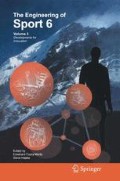Abstract
In the recent past, computer aided simulative models have been utilised to analyse the interaction of load and performance in training. The aim of the study was the evaluation of two models with antagonistic structure, the fitness-fatigue model and the PerPot model. Both were applied on an empirical dataset, containing training and performance data of ten sport students during an eight week cycling training period. The modelling was conducted using appropriate software tools. Results showed interindividually different qualities in fitting of modelled and empirical performances. Since the fitness-fatigue model resulted in marginal model parameters, interpretation remained questionable. The PerPot model offered reasonable delay values but due to different performance levels, interindividual comparison was difficult. For modelling the training-performance relationship both models revealed specific characteristics with some limitations in the interpretation of the model parameters.
Access this chapter
Tax calculation will be finalised at checkout
Purchases are for personal use only
Preview
Unable to display preview. Download preview PDF.
References
Banister, E. W. (1982). Modeling Elite Athletic Performance. In: J. D. MacDougall, H. W. Wenger & H. J. Green (Eds.), Physiological Testing of Elite Athletes (pp. 403–425). Champaign, Il.: Human Kinetics Publishers.
Busso, T., Denis, C., Bonnefroy, R., Geyssant, A., and Lacour, J.R. (1997). Modeling of adaptations to physical training by using a recursive least squares algorithm. Journal of Applied Physiology, 82 (5), 1685–1693.
Mester, J. and Perl, J. (2000). Grenzen der Anpassungs-und Leistungsfähigkeit des Menschen aus systemischer Sicht — Zeitreihenanalyse und ein informatisches Metamodell zur Untersuchung physiologischer Adaptationsprozesse. Leistungssport 30 (1), 43–51.
Perl, J. (2001). PerPot: A Metamodel for Simulation of Load Performance Interaction. Electronic Journal of Sport Science, 1, No. 2.
Perl, J. and Mester, J. (2001). Modellgestützte Analyse und Optimierung der Wechselwirkung zwischen Belastung und Leistung. Leistungssport, 31 (2), 54–62.
Author information
Authors and Affiliations
Editor information
Editors and Affiliations
Rights and permissions
Copyright information
© 2006 Springer Science+Business Media, LLC
About this paper
Cite this paper
Ganter, N., Witte, K., Edelmann-Nusser, J. (2006). Application of Different Computerized Methods for Modelling the Training-Performance Relationship. In: Moritz, E.F., Haake, S. (eds) The Engineering of Sport 6. Springer, New York, NY. https://doi.org/10.1007/978-0-387-45951-6_36
Download citation
DOI: https://doi.org/10.1007/978-0-387-45951-6_36
Publisher Name: Springer, New York, NY
Print ISBN: 978-0-387-34680-9
Online ISBN: 978-0-387-45951-6
eBook Packages: EngineeringEngineering (R0)

